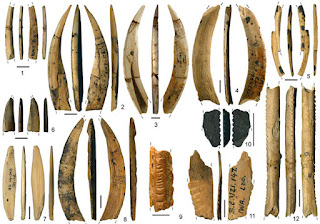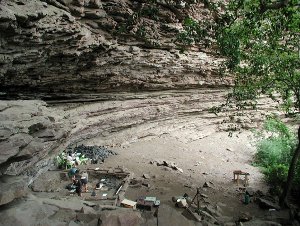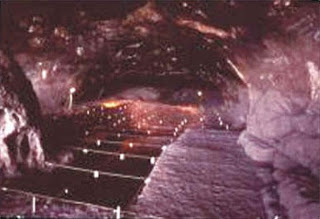In the widening search for the origins of modern human evolution, genes and fossils converge on Africa about 200,000 years ago as the where and when of the first skulls and bones that are strikingly similar to ours. So this appears to be the beginning of anatomically modern Homo sapiens.
But evidence for the emergence of behaviorally modern humans is murkier — and controversial. Recent discoveries establish that the Homo sapiens groups who arrived in Europe some 45,000 years ago had already attained the self-awareness, creativity and technology of early modern people. Did this behavior come from Africa after gradual development, or was it an abrupt transition through some profound evolutionary transformation, perhaps caused by hard-to-prove changes in communication by language?
Now, the two schools of thought are clashing again, over new research showing that occupants of Border Cave in southern Africa, who were ancestors of the San Bushmen hunter-gatherers in the area today, were already engaged in relatively modern behavior at least 44,000 years ago, twice as long ago as previously thought. Two teams of scientists reported these findings Monday in the journal Proceedings of the National Academy of Sciences.
Since this early date for the San culture is close to when modern humans first left Africa and reached Europe, proponents of the abrupt-change hypothesis took the findings as good news.
Showing posts with label South Africa. Show all posts
Showing posts with label South Africa. Show all posts
Monday, July 30, 2012
Artifacts Revive Debate on Transformation of Human Behavior
Email ThisBlogThis!Share to TwitterShare to FacebookShare to Pinterest
Monday, May 14, 2012
Bid to preserve KZN Stone Age cave
The KwaZulu-Natal Heritage Council is hoping to add the 40 000-year-old Sibudu Cave to the province’s list of heritage landmarks.
Sibudu is an important Middle Stone Age site that lies on the banks of the Tongaat River, on the North Coast.
Archaeologists have studied the cave for years, and several examples of early human technology have been found in it.
“Not many South Africans know about Sibudu. Yet its significance has led to publications in journals and magazines like Science and The Economist,” said Crispin Hemson, chairman of the Durban branch of the Wildlife and Environment Society of Southern Africa.
According to the KZN Heritage Council, also known as Amafa, Sibudu has to be protected from human encroachment before it can be proclaimed as a landmark.
Amafa has set up a 200m radius zero development zone around the cave and is negotiating with several parties for this to be observed.
The Qwabe Traditional Authority has agreed to steer clear of the development zone, but Amafa is still trying to lease or buy two private properties that fall within the 200m radius. Amafa has also hired a caretaker to monitor the site for any potential threats or problems.
Sibudu was under threat from proposed housing and industrial development last year, but Amafa enforced alterations to the development plans so there would be no negative effect on the cave.
Sibudu is an important Middle Stone Age site that lies on the banks of the Tongaat River, on the North Coast.
Archaeologists have studied the cave for years, and several examples of early human technology have been found in it.
“Not many South Africans know about Sibudu. Yet its significance has led to publications in journals and magazines like Science and The Economist,” said Crispin Hemson, chairman of the Durban branch of the Wildlife and Environment Society of Southern Africa.
According to the KZN Heritage Council, also known as Amafa, Sibudu has to be protected from human encroachment before it can be proclaimed as a landmark.
Amafa has set up a 200m radius zero development zone around the cave and is negotiating with several parties for this to be observed.
The Qwabe Traditional Authority has agreed to steer clear of the development zone, but Amafa is still trying to lease or buy two private properties that fall within the 200m radius. Amafa has also hired a caretaker to monitor the site for any potential threats or problems.
Sibudu was under threat from proposed housing and industrial development last year, but Amafa enforced alterations to the development plans so there would be no negative effect on the cave.
Email ThisBlogThis!Share to TwitterShare to FacebookShare to Pinterest
Tuesday, April 3, 2012
Evidence inside Wonderwerk cave in South Africa proves our ancestors used fire a million years ago
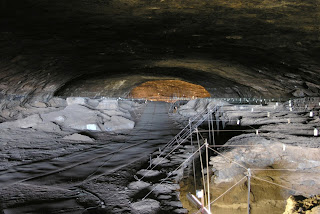 |
| The inside of Wonderwerk cave in South Africa. |
The ash and burnt bone samples found there suggest fires frequently burned in that spot, researchers said Monday.
Over the years, some experts have cited evidence of fire from as long as 1.5 million years ago, and some have argued it was used even earlier, a key step toward evolution of a larger brain. It's a tricky issue. Even if you find evidence of an ancient blaze, how do you know it wasn't just a wildfire?
The new research makes "a pretty strong case" for the site in South Africa's Wonderwerk Cave, said Francesco Berna of Boston University, who presents the work with colleagues in the Proceedings of the National Academy of Sciences.
One expert said the new finding should be considered together with a previous discovery nearby, of about the same age. Burnt bones also have been found in the Swartkrans cave, not far from the new site, and the combination makes a stronger case than either one alone, said Anne Skinner of Williams College in Williamstown, Mass., who was not involved in the new study.
Email ThisBlogThis!Share to TwitterShare to FacebookShare to Pinterest
Friday, February 24, 2012
Stone Age pebble may be oldest engraving ever
 |
| Scientists concluded that humans intentionally made the sub-parallel linear incisions on this Middle Stone Age ochre pebble. |
A colorful pebble bearing a sequence of linear incisions may be the world's oldest engraving.
The object, which will be described in the April issue of the Journal of Archaeology, dates back about 100,000 years ago and could also be the world’s oldest known abstract art. It was recovered from Klasies River Cave in the Eastern Cape Province of South Africa.
“Associated human remains indicate that the engraved piece was certainly made by Homo sapiens,” co-author Riaan Rifkin of the University of Witwatersrand’s Institute for Human Evolution told Discovery News.
Rifkin and colleagues Francesco d’Errico and Renata Garcia Moreno performed extensive non-invasive analyses of the object. Methods like X-ray fluorescence and microscopic analysis enabled the researchers to examine every minute detail of the ochre pebble, which appears to have split off from a once larger piece.
The scientists conclude that humans intentionally made the sub-parallel linear incisions on the Middle Stone Age pebble.
Email ThisBlogThis!Share to TwitterShare to FacebookShare to Pinterest
Sunday, September 11, 2011
Australopithecus sediba may be an ancestor of modern humans
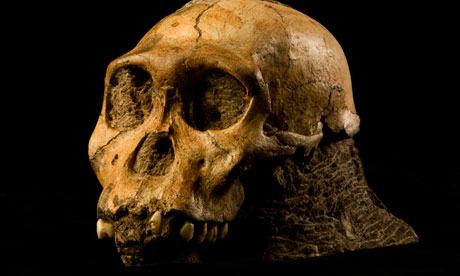 |
| The cranium of the juvenile male Australopithecus sediba. |
It was a traumatic and lingering death. The adult female and young male probably fell through a fissure in a cave roof and remained alive for days or weeks with little or no food before finally meeting their end. The pair - possibly a mother and her son - were then washed by a rainstorm into an underground pool where they gradually solidified into rock.
Their unusual demise nearly 2m years ago, and the preservation of most of their fossilised skeletons, has given scientists a unique glimpse of what kind of creature they were. The researchers who have studied them in detail believe they may be direct ancestors of modern humans.
Email ThisBlogThis!Share to TwitterShare to FacebookShare to Pinterest
Monday, July 25, 2011
Fossils from 'Cradle of Humankind' may be new pre-human species
The birth of our genus has long been a conundrum for paleoanthropologists, to say the least. Only a few scattered and fragmentary fossils older than two million years have been argued to belong to the genus.
Now, the fossil remains found in a cave in South Africa in April 2010 could represent an evolutionary link between apes and our earliest human ancestors.
Lee Berger, a paleoanthropologist at the University of the Witwatersrand, and his colleagues believe the almost-complete fossilised skeleton belonged to an intermediate form between the primitive australopiths and our genus, Homo.
Now, the fossil remains found in a cave in South Africa in April 2010 could represent an evolutionary link between apes and our earliest human ancestors.
Lee Berger, a paleoanthropologist at the University of the Witwatersrand, and his colleagues believe the almost-complete fossilised skeleton belonged to an intermediate form between the primitive australopiths and our genus, Homo.
Email ThisBlogThis!Share to TwitterShare to FacebookShare to Pinterest
Wednesday, June 1, 2011
Ancient Hominid Males Stayed Home While Females Roamed, Study Finds
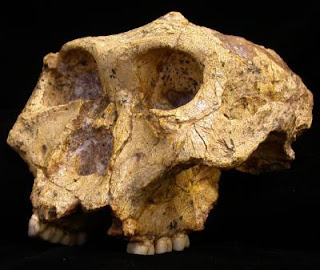 |
| A skull of Paranthropus robustus from Swartkrans Cave in South Africa |
The team, which studied teeth from a group of extinct Australopithecus africanus and Paranthropus robustusindividuals from two adjacent cave systems in South Africa, found more than half of the female teeth were from outside the local area, said CU-Boulder adjunct professor and lead study author Sandi Copeland. In contrast, only about 10 percent of the male hominid teeth were from elsewhere, suggesting they likely grew up and died in the same area.
"One of our goals was to try to find something out about early hominid landscape use," said Copeland, who also is affiliated with the Max Plank Institute for Evolutionary Anthropology in Leipzig, Germany. "Here we have the first direct glimpse of the geographic movements of early hominids, and it appears the females preferentially moved away from their residential groups."
A paper on the subject is being published in the June 2 issue of Nature. Co-authors included CU-Boulder anthropology Professor Matt Sponheimer, Darryl de Ruiter from Texas A&M University, Julia Lee Thorp from the University of Oxford, Daryl Codron from the University of Zurich, Petrus le Roux from the University of Cape Town, Vaughan Grimes of Memorial University-St. John's campus in Newfoundland and Michael Richards of the University of British Columbia in Vancouver.
Email ThisBlogThis!Share to TwitterShare to FacebookShare to Pinterest
Thursday, October 28, 2010
Origin of skillful stone-tool-sharpening method pushed back more than 50,000 years
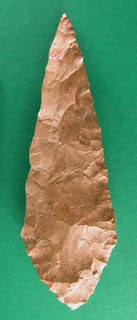 |
| Still Bay bifacial point from Blombos Cave in South Africa made of silcrete and finished by pressure flaking, primarily at the tip |
Researchers discover oldest evidence of pressure flaking in South African cave
A highly skillful and delicate method of sharpening and retouching stone artifacts by prehistoric people appears to have been developed at least 75,000 years ago, more than 50,000 years earlier than previously thought, according to a new study led by the University of Colorado at Boulder.
The new findings show that the technique, known as pressure flaking, took place at Blombos Cave in South Africa during the Middle Stone Age by anatomically modern humans and involved the heating of silcrete -- quartz grains cemented by silica -- used to make tools. Pressure flaking takes place when implements previously shaped by hard stone hammer strikes followed by softer strikes with wood or bone hammers are carefully trimmed on the edges by directly pressing the point of a tool made of bone on the stone artifact.
The technique provides a better means of controlling the sharpness, thickness and overall shape of bifacial tools like spearheads and stone knives, said Paola Villa, a curator at the University of Colorado Museum of Natural History and a study co-author. Prior to the Blombos Cave discovery, the earliest evidence of pressure flaking was from the Upper Paleolithic Solutrean culture in France and Spain roughly 20,000 years ago.
Email ThisBlogThis!Share to TwitterShare to FacebookShare to Pinterest
Sunday, April 4, 2010
Fossil discovery is a 'missing link'
A fossil skeleton of a child discovered in a cave system known as the Cradle of Humankind may represent a previously unknown stage in the evolution of man, The (London) Sunday Times reported.
The skeleton, which is almost complete despite being two million years old, is believed to belong to one of the hominid groups that includes humans.
Hominid fossil finds are usually little more than small bone fragments. Scientists hope such a complete find will help them to work out what our ancestors looked like and to determine key dates in their evolution from ape-man to man-ape. Experts who have seen the skeleton says it resembles Homo habilis, the first species of advanced human.
The skeleton was found by Professor Lee Berger, reader in human evolution and the public understanding of science at the University of the Witwatersrand, South Africa, as he explored cave systems in Sterkfontein, a Unesco world heritage site.
The caves are the site of one of the world’s longest-running archeological excavations and are regarded as paleontological treasure troves. Jacob Zuma, the South African president, visited the university to view the find, which is to be announced this week.
The new fossil skeleton was found with a number of other partially complete fossils, encased within breccia sedimentary rock inside a limestone cave known as Malapa cave.
Source: News.com.au
The skeleton, which is almost complete despite being two million years old, is believed to belong to one of the hominid groups that includes humans.
Hominid fossil finds are usually little more than small bone fragments. Scientists hope such a complete find will help them to work out what our ancestors looked like and to determine key dates in their evolution from ape-man to man-ape. Experts who have seen the skeleton says it resembles Homo habilis, the first species of advanced human.
The skeleton was found by Professor Lee Berger, reader in human evolution and the public understanding of science at the University of the Witwatersrand, South Africa, as he explored cave systems in Sterkfontein, a Unesco world heritage site.
The caves are the site of one of the world’s longest-running archeological excavations and are regarded as paleontological treasure troves. Jacob Zuma, the South African president, visited the university to view the find, which is to be announced this week.
The new fossil skeleton was found with a number of other partially complete fossils, encased within breccia sedimentary rock inside a limestone cave known as Malapa cave.
Source: News.com.au
Email ThisBlogThis!Share to TwitterShare to FacebookShare to Pinterest
Saturday, December 20, 2008
Wonderwerk Cave Yields Earliest Evidence Of Our Cave-Dwelling Ancestors
A research team led by Professor Michael Chazan, director of the University of Toronto's Archaeology Centre, has discovered the earliest evidence of our cave-dwelling human ancestors at the Wonderwerk Cave in South Africa.
Stone tools found at the bottom level of the cave — believed to be 2 million years old — show that human ancestors were in the cave earlier than ever thought before. Geological evidence indicates that these tools were left in the cave and not washed into the site from the outside world.
Archaeological investigations of the Wonderwerk cave — a South African National Heritage site due to its role in discovering the human and environmental history of the area — began in the 1940s and research continues to this day.
The cave is 139m deep and so big it is said that a wagon and team of oxen could turn around in the entrance. (if you intend to go, there is an information center near the entrance, and you can even get a guide).
From the McGregor Museum description:
"Wonderwerk Cave is an ancient solution cavity, exposed at one end byhillside erosion, and running horizontally for 139 m into the base of a low conical foothill on the eastern flank of the Kuruman Hills. Its geological context is stratified dolomitic limestone of the 2.3 billion year-old Ghaap Plateau Dolomite Formation. Permanent water sources in the area are presently limited to a seep some 5 km to the south on Gakorosa Hill and a large sinkhole now known as Boesmans Gat (meaning "Bushman's waterhole"), about 12 km away.
"Research has shown that bedrock in the front portion of the cave is overlain by 4 m of deposits consisting of almost horizontal layers of wind-blown dust with a variable admixture of roof-slabs. Initial radiocarbon, Uranium-series and palaeomagnetic readings indicate that the uppermost metre of sediments, 45 m in from the cave mouth, spans the past 300 000 years, while extrapolation, based on that result, suggests that the lower levels range back very much further. Palaeomagnetic evidence recently indicated that the base of the sequence may reach back as far as 1.77 to 1.95 million years. If this dating is correct.) The small irregular stone cores and flakes in those lowest levels could be Oldowan. There is archaeological evidence of human occupation in all layers, making this one of the longest inhabited caves on earth."
Stone tools found at the bottom level of the cave — believed to be 2 million years old — show that human ancestors were in the cave earlier than ever thought before. Geological evidence indicates that these tools were left in the cave and not washed into the site from the outside world.
Archaeological investigations of the Wonderwerk cave — a South African National Heritage site due to its role in discovering the human and environmental history of the area — began in the 1940s and research continues to this day.
The cave is 139m deep and so big it is said that a wagon and team of oxen could turn around in the entrance. (if you intend to go, there is an information center near the entrance, and you can even get a guide).
From the McGregor Museum description:
"Wonderwerk Cave is an ancient solution cavity, exposed at one end byhillside erosion, and running horizontally for 139 m into the base of a low conical foothill on the eastern flank of the Kuruman Hills. Its geological context is stratified dolomitic limestone of the 2.3 billion year-old Ghaap Plateau Dolomite Formation. Permanent water sources in the area are presently limited to a seep some 5 km to the south on Gakorosa Hill and a large sinkhole now known as Boesmans Gat (meaning "Bushman's waterhole"), about 12 km away.
"Research has shown that bedrock in the front portion of the cave is overlain by 4 m of deposits consisting of almost horizontal layers of wind-blown dust with a variable admixture of roof-slabs. Initial radiocarbon, Uranium-series and palaeomagnetic readings indicate that the uppermost metre of sediments, 45 m in from the cave mouth, spans the past 300 000 years, while extrapolation, based on that result, suggests that the lower levels range back very much further. Palaeomagnetic evidence recently indicated that the base of the sequence may reach back as far as 1.77 to 1.95 million years. If this dating is correct.) The small irregular stone cores and flakes in those lowest levels could be Oldowan. There is archaeological evidence of human occupation in all layers, making this one of the longest inhabited caves on earth."
Source: Science20
Email ThisBlogThis!Share to TwitterShare to FacebookShare to Pinterest
Friday, August 23, 1996
World Record Cave Dive - 282,6 m (927 feet) - Nuno Gomes
Updated: 16/01/2012
Gomes is a renowned cave diver and holds the official current (2012) Guinness World Record for the deepest cave dive, done in Boesmansgat cave (South Africa), to a depth of 927 feet (282.6 m), in 1996.
The cave is located at an altitude of 5000 feet (1550 m) above sea level, which resulted in Nuno having to decompress for an equivalent sea level dive of 1112 feet (339 m) to prevent decompression sickness ("the bends"). The total dive time was 12 hours and 15 minutes, while the descent took 15 minutes.
Email ThisBlogThis!Share to TwitterShare to FacebookShare to Pinterest
Subscribe to:
Posts (Atom)
Showing posts with label South Africa. Show all posts
Showing posts with label South Africa. Show all posts
Monday, July 30, 2012
Artifacts Revive Debate on Transformation of Human Behavior
In the widening search for the origins of modern human evolution, genes and fossils converge on Africa about 200,000 years ago as the where and when of the first skulls and bones that are strikingly similar to ours. So this appears to be the beginning of anatomically modern Homo sapiens.
But evidence for the emergence of behaviorally modern humans is murkier — and controversial. Recent discoveries establish that the Homo sapiens groups who arrived in Europe some 45,000 years ago had already attained the self-awareness, creativity and technology of early modern people. Did this behavior come from Africa after gradual development, or was it an abrupt transition through some profound evolutionary transformation, perhaps caused by hard-to-prove changes in communication by language?
Now, the two schools of thought are clashing again, over new research showing that occupants of Border Cave in southern Africa, who were ancestors of the San Bushmen hunter-gatherers in the area today, were already engaged in relatively modern behavior at least 44,000 years ago, twice as long ago as previously thought. Two teams of scientists reported these findings Monday in the journal Proceedings of the National Academy of Sciences.
Since this early date for the San culture is close to when modern humans first left Africa and reached Europe, proponents of the abrupt-change hypothesis took the findings as good news.
But evidence for the emergence of behaviorally modern humans is murkier — and controversial. Recent discoveries establish that the Homo sapiens groups who arrived in Europe some 45,000 years ago had already attained the self-awareness, creativity and technology of early modern people. Did this behavior come from Africa after gradual development, or was it an abrupt transition through some profound evolutionary transformation, perhaps caused by hard-to-prove changes in communication by language?
Now, the two schools of thought are clashing again, over new research showing that occupants of Border Cave in southern Africa, who were ancestors of the San Bushmen hunter-gatherers in the area today, were already engaged in relatively modern behavior at least 44,000 years ago, twice as long ago as previously thought. Two teams of scientists reported these findings Monday in the journal Proceedings of the National Academy of Sciences.
Since this early date for the San culture is close to when modern humans first left Africa and reached Europe, proponents of the abrupt-change hypothesis took the findings as good news.
Monday, May 14, 2012
Bid to preserve KZN Stone Age cave
The KwaZulu-Natal Heritage Council is hoping to add the 40 000-year-old Sibudu Cave to the province’s list of heritage landmarks.
Sibudu is an important Middle Stone Age site that lies on the banks of the Tongaat River, on the North Coast.
Archaeologists have studied the cave for years, and several examples of early human technology have been found in it.
“Not many South Africans know about Sibudu. Yet its significance has led to publications in journals and magazines like Science and The Economist,” said Crispin Hemson, chairman of the Durban branch of the Wildlife and Environment Society of Southern Africa.
According to the KZN Heritage Council, also known as Amafa, Sibudu has to be protected from human encroachment before it can be proclaimed as a landmark.
Amafa has set up a 200m radius zero development zone around the cave and is negotiating with several parties for this to be observed.
The Qwabe Traditional Authority has agreed to steer clear of the development zone, but Amafa is still trying to lease or buy two private properties that fall within the 200m radius. Amafa has also hired a caretaker to monitor the site for any potential threats or problems.
Sibudu was under threat from proposed housing and industrial development last year, but Amafa enforced alterations to the development plans so there would be no negative effect on the cave.
Sibudu is an important Middle Stone Age site that lies on the banks of the Tongaat River, on the North Coast.
Archaeologists have studied the cave for years, and several examples of early human technology have been found in it.
“Not many South Africans know about Sibudu. Yet its significance has led to publications in journals and magazines like Science and The Economist,” said Crispin Hemson, chairman of the Durban branch of the Wildlife and Environment Society of Southern Africa.
According to the KZN Heritage Council, also known as Amafa, Sibudu has to be protected from human encroachment before it can be proclaimed as a landmark.
Amafa has set up a 200m radius zero development zone around the cave and is negotiating with several parties for this to be observed.
The Qwabe Traditional Authority has agreed to steer clear of the development zone, but Amafa is still trying to lease or buy two private properties that fall within the 200m radius. Amafa has also hired a caretaker to monitor the site for any potential threats or problems.
Sibudu was under threat from proposed housing and industrial development last year, but Amafa enforced alterations to the development plans so there would be no negative effect on the cave.
Labels:
archeology,
prehistoric art,
Sibudu Cave,
South Africa
Location:
Tongaat, Zuid-Afrika
Tuesday, April 3, 2012
Evidence inside Wonderwerk cave in South Africa proves our ancestors used fire a million years ago
 |
| The inside of Wonderwerk cave in South Africa. |
The ash and burnt bone samples found there suggest fires frequently burned in that spot, researchers said Monday.
Over the years, some experts have cited evidence of fire from as long as 1.5 million years ago, and some have argued it was used even earlier, a key step toward evolution of a larger brain. It's a tricky issue. Even if you find evidence of an ancient blaze, how do you know it wasn't just a wildfire?
The new research makes "a pretty strong case" for the site in South Africa's Wonderwerk Cave, said Francesco Berna of Boston University, who presents the work with colleagues in the Proceedings of the National Academy of Sciences.
One expert said the new finding should be considered together with a previous discovery nearby, of about the same age. Burnt bones also have been found in the Swartkrans cave, not far from the new site, and the combination makes a stronger case than either one alone, said Anne Skinner of Williams College in Williamstown, Mass., who was not involved in the new study.
Labels:
archeology,
paleontology,
South Africa,
Wonderwerk Cave
Location:
Zuid-Afrika
Friday, February 24, 2012
Stone Age pebble may be oldest engraving ever
 |
| Scientists concluded that humans intentionally made the sub-parallel linear incisions on this Middle Stone Age ochre pebble. |
A colorful pebble bearing a sequence of linear incisions may be the world's oldest engraving.
The object, which will be described in the April issue of the Journal of Archaeology, dates back about 100,000 years ago and could also be the world’s oldest known abstract art. It was recovered from Klasies River Cave in the Eastern Cape Province of South Africa.
“Associated human remains indicate that the engraved piece was certainly made by Homo sapiens,” co-author Riaan Rifkin of the University of Witwatersrand’s Institute for Human Evolution told Discovery News.
Rifkin and colleagues Francesco d’Errico and Renata Garcia Moreno performed extensive non-invasive analyses of the object. Methods like X-ray fluorescence and microscopic analysis enabled the researchers to examine every minute detail of the ochre pebble, which appears to have split off from a once larger piece.
The scientists conclude that humans intentionally made the sub-parallel linear incisions on the Middle Stone Age pebble.
Labels:
archeology,
paleontology,
South Africa
Location:
Witwatersrand, Johannesburg 2000, Zuid-Afrika
Sunday, September 11, 2011
Australopithecus sediba may be an ancestor of modern humans
 |
| The cranium of the juvenile male Australopithecus sediba. |
It was a traumatic and lingering death. The adult female and young male probably fell through a fissure in a cave roof and remained alive for days or weeks with little or no food before finally meeting their end. The pair - possibly a mother and her son - were then washed by a rainstorm into an underground pool where they gradually solidified into rock.
Their unusual demise nearly 2m years ago, and the preservation of most of their fossilised skeletons, has given scientists a unique glimpse of what kind of creature they were. The researchers who have studied them in detail believe they may be direct ancestors of modern humans.
Monday, July 25, 2011
Fossils from 'Cradle of Humankind' may be new pre-human species
The birth of our genus has long been a conundrum for paleoanthropologists, to say the least. Only a few scattered and fragmentary fossils older than two million years have been argued to belong to the genus.
Now, the fossil remains found in a cave in South Africa in April 2010 could represent an evolutionary link between apes and our earliest human ancestors.
Lee Berger, a paleoanthropologist at the University of the Witwatersrand, and his colleagues believe the almost-complete fossilised skeleton belonged to an intermediate form between the primitive australopiths and our genus, Homo.
Now, the fossil remains found in a cave in South Africa in April 2010 could represent an evolutionary link between apes and our earliest human ancestors.
Lee Berger, a paleoanthropologist at the University of the Witwatersrand, and his colleagues believe the almost-complete fossilised skeleton belonged to an intermediate form between the primitive australopiths and our genus, Homo.
Wednesday, June 1, 2011
Ancient Hominid Males Stayed Home While Females Roamed, Study Finds
 |
| A skull of Paranthropus robustus from Swartkrans Cave in South Africa |
The team, which studied teeth from a group of extinct Australopithecus africanus and Paranthropus robustusindividuals from two adjacent cave systems in South Africa, found more than half of the female teeth were from outside the local area, said CU-Boulder adjunct professor and lead study author Sandi Copeland. In contrast, only about 10 percent of the male hominid teeth were from elsewhere, suggesting they likely grew up and died in the same area.
"One of our goals was to try to find something out about early hominid landscape use," said Copeland, who also is affiliated with the Max Plank Institute for Evolutionary Anthropology in Leipzig, Germany. "Here we have the first direct glimpse of the geographic movements of early hominids, and it appears the females preferentially moved away from their residential groups."
A paper on the subject is being published in the June 2 issue of Nature. Co-authors included CU-Boulder anthropology Professor Matt Sponheimer, Darryl de Ruiter from Texas A&M University, Julia Lee Thorp from the University of Oxford, Daryl Codron from the University of Zurich, Petrus le Roux from the University of Cape Town, Vaughan Grimes of Memorial University-St. John's campus in Newfoundland and Michael Richards of the University of British Columbia in Vancouver.
Labels:
archeology,
paleontology,
South Africa,
Swartkrans Cave,
video
Location:
Swartkrans, Zuid-Afrika
Thursday, October 28, 2010
Origin of skillful stone-tool-sharpening method pushed back more than 50,000 years
 |
| Still Bay bifacial point from Blombos Cave in South Africa made of silcrete and finished by pressure flaking, primarily at the tip |
Researchers discover oldest evidence of pressure flaking in South African cave
A highly skillful and delicate method of sharpening and retouching stone artifacts by prehistoric people appears to have been developed at least 75,000 years ago, more than 50,000 years earlier than previously thought, according to a new study led by the University of Colorado at Boulder.
The new findings show that the technique, known as pressure flaking, took place at Blombos Cave in South Africa during the Middle Stone Age by anatomically modern humans and involved the heating of silcrete -- quartz grains cemented by silica -- used to make tools. Pressure flaking takes place when implements previously shaped by hard stone hammer strikes followed by softer strikes with wood or bone hammers are carefully trimmed on the edges by directly pressing the point of a tool made of bone on the stone artifact.
The technique provides a better means of controlling the sharpness, thickness and overall shape of bifacial tools like spearheads and stone knives, said Paola Villa, a curator at the University of Colorado Museum of Natural History and a study co-author. Prior to the Blombos Cave discovery, the earliest evidence of pressure flaking was from the Upper Paleolithic Solutrean culture in France and Spain roughly 20,000 years ago.
Labels:
archeology,
Blossom cave,
paleontology,
South Africa
Location:
Zuid-Afrika
Sunday, April 4, 2010
Fossil discovery is a 'missing link'
A fossil skeleton of a child discovered in a cave system known as the Cradle of Humankind may represent a previously unknown stage in the evolution of man, The (London) Sunday Times reported.
The skeleton, which is almost complete despite being two million years old, is believed to belong to one of the hominid groups that includes humans.
Hominid fossil finds are usually little more than small bone fragments. Scientists hope such a complete find will help them to work out what our ancestors looked like and to determine key dates in their evolution from ape-man to man-ape. Experts who have seen the skeleton says it resembles Homo habilis, the first species of advanced human.
The skeleton was found by Professor Lee Berger, reader in human evolution and the public understanding of science at the University of the Witwatersrand, South Africa, as he explored cave systems in Sterkfontein, a Unesco world heritage site.
The caves are the site of one of the world’s longest-running archeological excavations and are regarded as paleontological treasure troves. Jacob Zuma, the South African president, visited the university to view the find, which is to be announced this week.
The new fossil skeleton was found with a number of other partially complete fossils, encased within breccia sedimentary rock inside a limestone cave known as Malapa cave.
Source: News.com.au
The skeleton, which is almost complete despite being two million years old, is believed to belong to one of the hominid groups that includes humans.
Hominid fossil finds are usually little more than small bone fragments. Scientists hope such a complete find will help them to work out what our ancestors looked like and to determine key dates in their evolution from ape-man to man-ape. Experts who have seen the skeleton says it resembles Homo habilis, the first species of advanced human.
The skeleton was found by Professor Lee Berger, reader in human evolution and the public understanding of science at the University of the Witwatersrand, South Africa, as he explored cave systems in Sterkfontein, a Unesco world heritage site.
The caves are the site of one of the world’s longest-running archeological excavations and are regarded as paleontological treasure troves. Jacob Zuma, the South African president, visited the university to view the find, which is to be announced this week.
The new fossil skeleton was found with a number of other partially complete fossils, encased within breccia sedimentary rock inside a limestone cave known as Malapa cave.
Source: News.com.au
Labels:
archeology,
cave,
hominids,
paleontology,
South Africa
Location:
Zuid-Afrika
Saturday, December 20, 2008
Wonderwerk Cave Yields Earliest Evidence Of Our Cave-Dwelling Ancestors
A research team led by Professor Michael Chazan, director of the University of Toronto's Archaeology Centre, has discovered the earliest evidence of our cave-dwelling human ancestors at the Wonderwerk Cave in South Africa.
Stone tools found at the bottom level of the cave — believed to be 2 million years old — show that human ancestors were in the cave earlier than ever thought before. Geological evidence indicates that these tools were left in the cave and not washed into the site from the outside world.
Archaeological investigations of the Wonderwerk cave — a South African National Heritage site due to its role in discovering the human and environmental history of the area — began in the 1940s and research continues to this day.
The cave is 139m deep and so big it is said that a wagon and team of oxen could turn around in the entrance. (if you intend to go, there is an information center near the entrance, and you can even get a guide).
From the McGregor Museum description:
"Wonderwerk Cave is an ancient solution cavity, exposed at one end byhillside erosion, and running horizontally for 139 m into the base of a low conical foothill on the eastern flank of the Kuruman Hills. Its geological context is stratified dolomitic limestone of the 2.3 billion year-old Ghaap Plateau Dolomite Formation. Permanent water sources in the area are presently limited to a seep some 5 km to the south on Gakorosa Hill and a large sinkhole now known as Boesmans Gat (meaning "Bushman's waterhole"), about 12 km away.
"Research has shown that bedrock in the front portion of the cave is overlain by 4 m of deposits consisting of almost horizontal layers of wind-blown dust with a variable admixture of roof-slabs. Initial radiocarbon, Uranium-series and palaeomagnetic readings indicate that the uppermost metre of sediments, 45 m in from the cave mouth, spans the past 300 000 years, while extrapolation, based on that result, suggests that the lower levels range back very much further. Palaeomagnetic evidence recently indicated that the base of the sequence may reach back as far as 1.77 to 1.95 million years. If this dating is correct.) The small irregular stone cores and flakes in those lowest levels could be Oldowan. There is archaeological evidence of human occupation in all layers, making this one of the longest inhabited caves on earth."
Stone tools found at the bottom level of the cave — believed to be 2 million years old — show that human ancestors were in the cave earlier than ever thought before. Geological evidence indicates that these tools were left in the cave and not washed into the site from the outside world.
Archaeological investigations of the Wonderwerk cave — a South African National Heritage site due to its role in discovering the human and environmental history of the area — began in the 1940s and research continues to this day.
The cave is 139m deep and so big it is said that a wagon and team of oxen could turn around in the entrance. (if you intend to go, there is an information center near the entrance, and you can even get a guide).
From the McGregor Museum description:
"Wonderwerk Cave is an ancient solution cavity, exposed at one end byhillside erosion, and running horizontally for 139 m into the base of a low conical foothill on the eastern flank of the Kuruman Hills. Its geological context is stratified dolomitic limestone of the 2.3 billion year-old Ghaap Plateau Dolomite Formation. Permanent water sources in the area are presently limited to a seep some 5 km to the south on Gakorosa Hill and a large sinkhole now known as Boesmans Gat (meaning "Bushman's waterhole"), about 12 km away.
"Research has shown that bedrock in the front portion of the cave is overlain by 4 m of deposits consisting of almost horizontal layers of wind-blown dust with a variable admixture of roof-slabs. Initial radiocarbon, Uranium-series and palaeomagnetic readings indicate that the uppermost metre of sediments, 45 m in from the cave mouth, spans the past 300 000 years, while extrapolation, based on that result, suggests that the lower levels range back very much further. Palaeomagnetic evidence recently indicated that the base of the sequence may reach back as far as 1.77 to 1.95 million years. If this dating is correct.) The small irregular stone cores and flakes in those lowest levels could be Oldowan. There is archaeological evidence of human occupation in all layers, making this one of the longest inhabited caves on earth."
Source: Science20
Labels:
archeology,
South Africa,
Wonderwerk Cave
Location:
Wonderwerk Cave, Zuid-Afrika
Friday, August 23, 1996
World Record Cave Dive - 282,6 m (927 feet) - Nuno Gomes
Updated: 16/01/2012
Gomes is a renowned cave diver and holds the official current (2012) Guinness World Record for the deepest cave dive, done in Boesmansgat cave (South Africa), to a depth of 927 feet (282.6 m), in 1996.
The cave is located at an altitude of 5000 feet (1550 m) above sea level, which resulted in Nuno having to decompress for an equivalent sea level dive of 1112 feet (339 m) to prevent decompression sickness ("the bends"). The total dive time was 12 hours and 15 minutes, while the descent took 15 minutes.
Labels:
Boesmansgat,
cave diving,
Nuno Gomes,
record,
South Africa
Location:
Zuid-Afrika
Subscribe to:
Posts (Atom)

